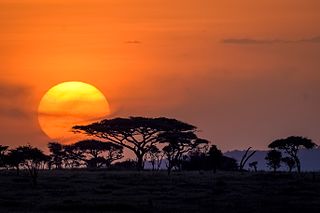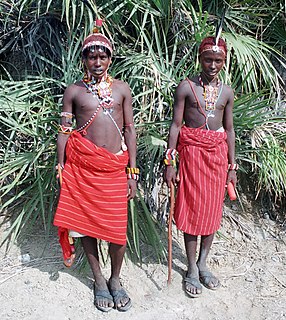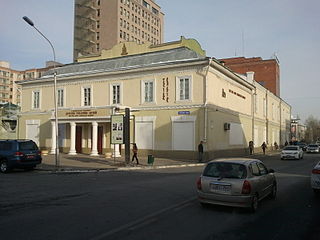
The Kipsigis, are a South Eastern Nilotic people who predominantly live in western region of Kenya within the larger Kericho District of the former Rift Valley province. Their eponym roughly translates as 'a repductively successful bunch'. The IBEAC company and the British colonial government referred to the Kipsigis people as 'Lumbwa' and 'Kwavi'. The Kipsigis people speak the Kipsigis language; a Nilotic language which falls under the Nandi-Markweta cluster of the Kalenjin languages.. The Kipsigis together with other linguistically and culturally related peoples now identify as Kalenjin, an identity they have been collectively using since the 1950s. The Kipsigis people in census and other statistics are the most populous compared to their akin tribes of Kalenjin.

Maasai Mara, also sometimes spelled Masai Mara and locally known simply as The Mara, is a large national game reserve in Narok, Kenya, contiguous with the Serengeti National Park in Tanzania. It is named in honor of the Maasai people, the ancestral inhabitants of the area, who migrated to the area from the Nile Basin. Their description of the area when looked at from afar: "Mara" means "spotted" in the local Maasai language, due to the many short bushy trees which dot the landscape.

The Maasai are a Nilotic ethnic group inhabiting northern, central and southern Kenya and northern Tanzania. They are among the best known local populations internationally due to their residence near the many game parks of the African Great Lakes, and their distinctive customs and dress. The Maasai speak the Maa language, a member of the Nilotic language family that is related to the Dinka, Kalenjin and Nuer languages. Except for some elders living in rural areas, most Maasai people speak the official languages of Kenya and Tanzania, Swahili and English. The Maasai population has been reported as numbering 1,189,522 in Kenya in the 2019 census, compared to 377,089 in the 1989 census. Many Maasai tribes throughout Tanzania and Kenya welcome visits to their villages to experience their culture, traditions, and lifestyle, in return for a fee.

The Serengeti ecosystem is a geographical region in Africa, spanning northern Tanzania. The protected area within the region includes approximately 30,000 km2 (12,000 sq mi) of land, including the Serengeti National Park and several game reserves. The Serengeti hosts the second largest terrestrial mammal migration in the world, which helps secure it as one of the Seven Natural Wonders of Africa, and as one of the ten natural travel wonders of the world.
The Nilotic peoples are peoples indigenous to the Nile Valley who speak Nilotic languages. They inhabit South Sudan, Sudan, Ethiopia, Uganda, Kenya, the Democratic Republic of the Congo, Rwanda, and Tanzania. Among these are the Burun-speaking peoples, Karo peoples, Luo peoples, Ateker peoples, Kalenjin peoples, Datooga, Dinka, Nuer, Atwot, Lotuko, and the Maa-speaking peoples.

An adornment is generally an accessory or ornament worn to enhance the beauty or status of the wearer. They are often worn to embellish, enhance, or distinguish the wearer, and to define cultural, social, or religious status within a specific community. When worn to show economic status, the items are often either rare or prohibitively expensive to others. Adornments are usually colourful, and worn to attract attention.

The Samburu are a Nilotic people of north-central Kenya. Samburu are semi-nomadic pastoralists who herd mainly cattle but also keep sheep, goats and camels. The name they use for themselves is Lokop or Loikop, a term which may have a variety of meanings which Samburu themselves do not agree on. Many assert that it refers to them as "owners of the land" though others present a very different interpretation of the term. Samburu speak the Samburu dialect of the Maa language, which is a Nilotic language. The Maa language is also spoken by other 22 sub tribes of the Maa community otherwise known as the Maasai. Many Western anthropologists tried to carve out and create the Samburu tribe as a community of its own, unaffiliated to its parent Maasai community, a narrative that seems that many Samburu people today hold. There are many game parks in the area, one of the most well known is Samburu National Reserve. The Samburu sub tribe is the third largest in the Maa community of Kenya and Tanzania, after the Kisonko (Isikirari) of Tanzania and Purko of Kenya and Tanzania.

The Kalenjin comprise a number of Southern Nilotic ethnic groups indigenous to what was formerly the Rift Valley Province in Kenya. They number 6,358,113 individuals as per the Kenyan 2019 census. They are divided into 11 culturally and linguistically related tribes: Kipsigis, Nandi, Keiyo, Marakwet, Sabaot, Pokots, Tugen, Terik, Sengwer, Lembus, and Ogiek.

Maasai (Masai) or Maa is an Eastern Nilotic language spoken in Southern Kenya and Northern Tanzania by the Maasai people, numbering about 800,000. It is closely related to the other Maa varieties: Samburu, the language of the Samburu people of central Kenya, Chamus, spoken south and southeast of Lake Baringo ; and Parakuyu of Tanzania. The Maasai, Samburu, il-Chamus and Parakuyu peoples are historically related and all refer to their language as ɔl Maa. Properly speaking, "Maa" refers to the language and the culture and "Maasai" refers to the people "who speak Maa."
The Yaaku, are a people who are said to have lived in regions of southern Ethiopia and central Kenya, possibly through to the 18th century. The language they spoke is today called Yaakunte. The Yaaku assimilated a hunter-gathering population, whom they called Mukogodo, when they first settled in their place of origin and the Mukogodo adopted the Yaakunte language. However, the Yaaku were later assimilated by a food producing population and they lost their way of life. The Yaakunte language was kept alive for sometime by the Mukogodo who maintained their own hunter-gathering way of life, but they were later immersed in Maasai culture and adopted the Maa language and way of life. The Yaakunte language is today facing extinction but is undergoing a revival movement. In the present time, the terms Yaaku and Mukogodo, are used to refer to a population living in Mukogodo forest west of Mount Kenya.
Yaaku is an endangered Afroasiatic language spoken in Kenya. It is Cushitic, but its position within that family has been unclear. Bender 2020 [2008] concluded it was Omo–Tana ('Arboroid'). Speakers are all older adults.
Ledama Olekina is a Kenyan politician who serves as the senator for Narok County. Olekina was elected on an Orange Democratic Movement ticket in the August 8, 2017, general elections in Kenya. He was born and raised in Oloombokishi, a small village near Narok, Kenya, on 11 November 1974. As of 2020, he resides in Eor Ekule, Enkanasa Village. Olekina was educated at Narok High School and thereafter proceeded to the United States where he earned a Bachelor of Arts Degree in Political Science and English Communication from The University of Massachusetts in Boston in 2002. He is the founder of Maasai Education Discovery, an education center for girls. Olekina has been involved in efforts to conserve the Mau Forest in Kenya. [6] He is the most followed maasai politician on Facebook and Twitter,

Lake Jipe is an inter-territorial lake straddling the borders of Kenya and Tanzania. On the Kenyan side, it is located south of the village of Nghonji while on the Tanzanian side, it is situated within Mwanga District, in Kilimanjaro Region. The lake is fed mainly by the Lumi River, which descends from Mount Kilimanjaro, as well as streams from the North Pare Mountains, being on the leeward side. The lake's outlet forms the Ruvu River. Kenya's unfenced Tsavo West National Park protects part of the lake's northern shore, while on the Tanzania side Mkomazi Game Reserve is nearby. The lake is known for its endemic fish, as well as water birds, mammals, wetland plants and lake-edge swamps, which can extend 2 kilometres (1.2 mi) from Jipe's shore.

The Malindi Museum is a museum located in Malindi, Kenya. The museum is dedicated to the history of the ethnic groups of the Kenyan coast as well as the marine animals that inhabit it.
Maasai Mara University (MMU),, is a public university in Kenya.
Kurito ole Kisio was a Mau Mau general who was killed in Narok, Kenya, in 1954. One of the lesser known leaders of the rebellion, Kisio was the highest ranking Mau Mau leader from the Maasai community. He fought alongside Turesh ole Tikani and Muntet ole Nkapiani. Although little is known about him today, Kisio's role in the freedom movement was important because it shows the Mau Mau Uprising was not a Kikuyu-only affair. According to Mau Mau chronicler Karari Njama, ole Kisio was the fourth most powerful man within Mau Mau ranks. He had an army of about 800 fighters operating from Melili Forest in Narok.

The Fine Arts Zanabazar Museum is an art museum located in Ulaanbaatar, capital of Mongolia, and founded in 1966. It exhibits collections of Mongolian masters of fine arts from the 18th to the 20th century and works in cooperation with the UNESCO for improving the presentation of its collections.
Angama Mara Airport is a small airport near Angama Mara in Narok County, Kenya. The airport serves the local areas of the Maasai Mara, national park and nature reserve. The airport was formerly known as Angama Mara Airstrip. In August 2021, the Kenya Airports Authority (KAA) began phased improvements and expansion to convert it to a fully fledged airport.
The Wray Memorial Museum, sometimes called the Shagalla Cultural Museum, is a museum located in Teri, Kenya, and is dedicated to displaying religious artifacts. The museum also exhibits cultural artifacts from the Sagalla community.

The Jaramogi Oginga Odinga Mausoleum is a mausoleum and museum that exhibits artifacts related to Jaramogi Oginga Odinga and other political figures in Kenya's independence process. The museum also displays artifacts related to the Luo culture.











